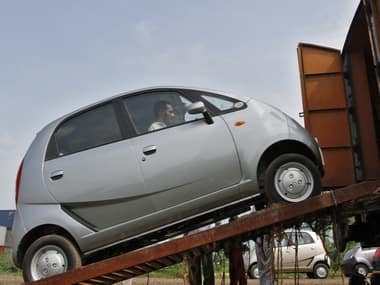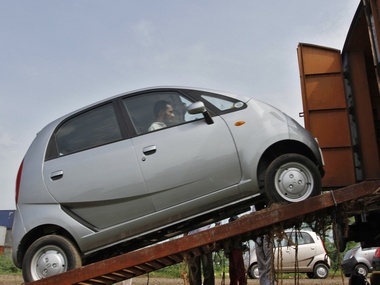The world’s cheapest car, Nano, is not a flop. So says Ratan Tata, the soon-to-retire head of the $83 billion Tata business empire, whose group company, Tata Motors, is the creator the high-profile compact car.
Tata admits the group made mistakes with the launch of the car in 2009, especially in advertising, dealership networks and technical issues.But he’s not writing off the Nano just yet. “I don’t consider it a flop,” he told reporters at the Auto Show in Delhi. “I consider it that we have wasted an opportunity.”
He added: “I believe we will see a resurrection of this product as we move forward,” Tata said. “Whatever stigma has been attached to it will be undone.”
[caption id=“attachment_174415” align=“alignleft” width=“380” caption=“The Nano by Tata Motors. Reuters”]
 [/caption]
[/caption]
The car has fared poorly among Indian buyers ever since it launched in 2009, hit by negative perception that the model was a ‘poor man’s vehicle’ and a couple of fires. Difficulties in procuring finance also put off buyers. Over the years, the starting price of the car, which was originally dubbed the ‘Rs 1 lakh car’, also climbed to Rs 1.4 lakh.
In December, Tata sold 7,466 Nanos, far from the 20,000-plus units Tata Motors once expected to sell every month.
A second coming for the Nano?
Given all the problems the car is saddled with, can the Nano make a successful comeback?
Impact Shorts
More ShortsThe bet has to be in favour of Tata, because he has a track record of proving his detractors wrong. Consider these points:
Point 1: Remember the torrents of criticism Ratan Tata faced when the group announced the Jaguar Land Rover acquisition from Ford for $2.3 billion in late 2007? Skeptics derided the deal, claiming it was expensive, unnecessary and an ‘act of vanity’ by Ratan Tata.
The move was also a significant departure for Tata Motors, which, until then, had experience mainly in making trucks and commercial vehicles. It had absolutely zilch knowledge of the luxury market - the market that Jaguar and Land Rover belonged.
Grumpy stock markets also didn’t like the deal and hammered Tata Motors for quite a while.
Well, three years on, sales of Jaguar Land Rover, under the Tata group, have made a spectacular rebound. By the end of March 2011, 80 percent of Tata Motors’ $2.04 billion annual profit came from the JLR unit alone.
As this post at Trak.in points out, “When Tata Motors took over in 2007, Jaguar had annual sales figures of 15,700 cars and Land Rover had sold just under 50,000 cars. In just three short years, Tata Motors has managed to sell a whopping 244,000 Jaguar and Land Rover cars globally.”
The numbers tell us that Ratan Tata is well-versed in the art of making critics eat their words. So, if he says the Nano will overcome its current problems, it would probably be wise not to bet against him.
Point 2: No other car manufacturer in India has come close to matching the aggressive pricing of the Nano. Several media reports have called Bajaj’s RE60 a possible challenger to the Nano, but the company itself refrains from calling the ultra-cost four-wheeler a “car”.
Given that the RE60 is targeting three-wheeler rickshaw taxis, not families, as its target market, the Nano and the RE60 are not direct rivals. The Nano remains the cheapest car for individuals/families; Tata Motors just needs to find a way to market that edge without making the Nano look like a cut-price version of a car.
Point 3: The company has listened to feedback from customers and incorporated some much-needed changes in its recently-launched variant. They have mildly improved the image of the car. The new version boasts new colours, better interiors, some hardware upgrades and a slightly more powerful engine - and a new starter motor. All this at the same price of the original Nano.
A new advertising campaign also positions the Nano as a hip, zippy model for first-time car buyers, and moves away from the ‘cheap’ price tag of the model. That will help in reducing criticism that the car has no ‘aspirational’ value.
Point 4: Thiscould be the biggest game changer for the Nano - a diesel version will be available in the market in a year’s time or so. Given that petrol prices are now 56 percent higher than diesel in India, a diesel variant could be just what the Nano needs to fire up sales.
Of course, none of these suggest that the Nano will become an overnight success. To be sure, the road ahead is long and rocky. But given that Ratan Tata was the primary force behind the Nano, it’s highly unlikely he will retire with the knowledge that the failure of the Nano will be part of his legacy.
The Nano will get a second chance - and it will come soon enough.
)